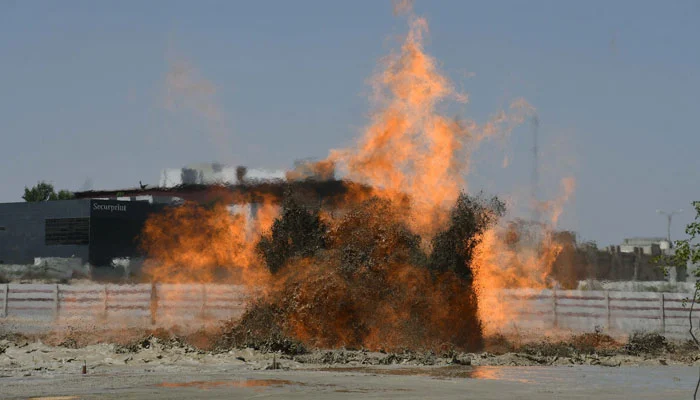KARACHI, April 07: Pakistan Petroleum Limited (PPL) is preparing to begin operations to contain and extinguish a persistent fire that erupted last month during borehole drilling in the Korangi Creek area near an oil refinery.
This follows the release of a detailed report indicating dangerously high levels of various gases and minerals, including benzene, toluene, iron, and magnesium, detected in underground water and soil samples.
According to Korangi Deputy Commissioner Masood Bhutto, the investigation report compiled by relevant experts has confirmed the presence of “heavy metals” and elevated levels of hazardous gases beneath the surface.
Speaking to media, DC Bhutto noted that the findings prompted PPL to plan the initiation of containment efforts with technical support from specialists.
This would be followed by further gas exploration to assess the spread of underground gases, potentially stretching over a five-kilometre radius.
He recalled that initially, PPL experts had speculated that the area contained only shallow gas pockets, which were expected to dissipate naturally.
Based on this assumption, authorities and rescue teams paused extinguishing efforts, fearing that intervention might be dangerous and counterproductive.
“However, the flames have shown no sign of reduction in intensity even after eight days, which contradicts the original assumption. Now, PPL has decided to undertake exploration to determine the presence and extent of gas in the reservoir,” Bhutto added.
The incident originated during drilling work for a high-rise development project, where borehole excavation went as deep as 1,200 feet.
Read More: Rare Asiatic Desert Big Cat Found in D G Khan Sulaiman Range
Officials now believe that the drilling may have fractured underground shale layers, releasing gas that subsequently ignited and led to the ongoing fire.
Hazardous Chemical Readings
Rescue 1122 spokesperson Hassaan Khan confirmed the expert report’s findings had been shared with emergency responders.
He highlighted alarming levels of chemical contamination in boiling water samples collected from the site.
According to Khan, the chemical analysis revealed benzene, toluene, and tetrachloroethane in quantities exceeding safe limits.
Specifically, tetrachloroethane was measured at 33 micrograms per litre—more than six times the permissible level of 5 micrograms per litre.
Also Read: Pakistan Discovers Major Gas Reserves with SIFC’s Backing
Similarly, benzene concentrations reached 19 micrograms per litre, nearly four times the allowable limit, while toluene levels were measured at 15 micrograms per litre, also triple the standard.
In terms of metal content, the report found the following levels:
-
Iron: 181.6 mg/L (against the acceptable limit of 0.005 mg/L)
-
Arsenic: 0.014 mg/L
-
Manganese: 2.721 mg/L
-
Lead: 0.032 mg/L (surpassing the reporting limit of 0.005 mg/L)
Although these findings confirm significant chemical concentrations in the groundwater, the exact quantities of the gases present beneath the surface remain undetermined.
Corporate Response and Background
In a recent disclosure to the Pakistan Stock Exchange (PSX), TPL Properties—the company behind the development project—confirmed that its team encountered a gas pocket during preliminary site investigations for water drilling near Korangi Creek.
“Initial evaluations, as well as insights from independent industry experts, suggest that the gas is likely shallow biogenic methane—formed naturally through the decomposition of organic matter,” the company stated.
“This location does not fall within any known gas field, and similar incidents elsewhere have shown such gas pockets typically dissipate on their own, provided the flame is allowed to continue burning.”
TPL Properties further clarified that the recent test drilling was part of a multi-year evaluation process aimed at ensuring responsible development.
These assessments have included geotechnical and environmental studies, electrical resistivity surveys, hydrological assessments, and a full environmental and social impact analysis—all conducted with official approvals and in compliance with regulatory requirements.
